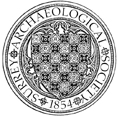16 Bell Street, Reigate
Excavation by D.W. Williams for Holmesdale Archaeological Group and SyAS (second season, 1975-6) located part of a 13th century building probably demolished in the 16th century, cut by a well or soakaway filled in in the 17th century, and an 18th century pit. South of this building was a revetted ditch filled in probably in the early 14th century, and traces of a possible outbuilding demolished in the 16th century. Other late finds were made. (128)


